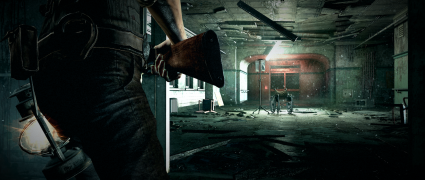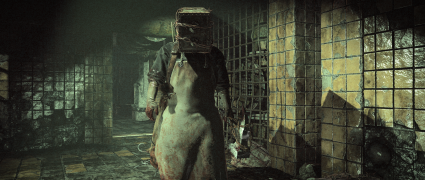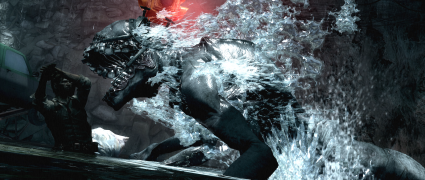Reviews
The Evil Within
November 24, 2014, Author: Andy Corrigan
When arranging with the team who would be reviewing what during this year’s silly season, I had a choice between two horror games, Alien: Isolation and The Evil Within. It’s pretty obvious what I opted for as, well, I’m talking to you right now in a review titled ‘The Evil Within’ and Matt Parker has already delivered his thoughts on the former. I made my choice on one basis: The Evil Within was created by Shinji Mikami and his new studio, Tango Gameworks. Mikami was, of course, the lead behind the second best game of all time, Resident Evil 4, and more recently entertained me greatly with his campy collaboration with Suda 51, Shadows of the Damned.
Thankfully, despite the occasional hiccup, The Evil Within delivers another satisfying, brutal survival horror experience typical of its creator.
The Evil Within has you play as Detective Sebastian Castellanos, as he and his team are called to investigate reports of ‘multiple homicides’ at the nearby Beacon Mental Hospital. As they arrive, there’s evidence of a huge police presence, yet there’s no one to be seen. Black and white cars litter the deserted forecourt, but there’s no sign of shots fired, just the sound of rain against Beacon’s stunning and imposing gothic backdrop. The sights inside the facility tell a different story, however, as everyone – cops, patients and staff – have been mercilessly slaughtered. Able to quickly get past the initial horror, the team make a beeline for the security room where, on camera, they see more of their comrades mutilated by a ghostly, seemingly unstoppable presence.
It’s here that Sebastian loses consciousness and it all gets a bit weird. Weird and terrifying.

I’m sure it’s going to be fine…
Castellanos wakes alone in a world where everything is seemingly out to kill him, from possessed civilians to hulking, chainsaw-wielding madmen, plus more surreal nasties to boot. There’s more to Beacon Medical Hospital than meets the eye and, over the tough, fifteen chapter campaign, both you and he will find out why in the most punishing manner possible.
Unfortunately, Evil Within’s reluctance to offer you any tangible information as to what’s going on until the last few levels really works against it narratively. Even as late as fourteen hours in, I felt that it was excelling at providing lots of undoubtedly creepy, self-contained scenarios, but offered me very little in the way of a coherent or compelling story arch to stitch them together. Thankfully, the action in those scenarios certainly proved impetus enough to keep playing.
Let me leave you under no illusions at this point: The Evil Within is brutal. Not once does it attempt to hold your hand, nor does it make any effort to explain to you its structure – or anything at all for that matter – leaving you to slowly feel it all out for yourself. This can, of course, lead to some confusion early on as to whether you’re heading in the right direction or trying to achieve the right goals, and usually I’d attribute this to poor design. Yet here, it feels entirely deliberate, as if it’s just another way for the developer to unnerve you, to pile as much uncertainty on you in the period in which you feel most vulnerable. As a tactic, it works.
From the off, Evil Within seems to set itself up as some sort of stealth horror game where hiding, evading and performing sneak attacks are your only real option, but once you get a handle on its rhythm, it’s easy to see that Resident Evil 4’s DNA runs very strongly throughout. The standard not-zombies that make up most of the combat in-between epic boss fights, for example, will hunt you relentlessly and rush you in precisely the same way as in Mikami’s Gamecube/PS2 masterpiece. They attack smartly in numbers, hurling knives and axes at you, and later on shooting right back.

This guy will haunt your nightmares.
Thankfully, you have similar moves and handling to good ol’ Leon Kennedy and enemies are extremely susceptible to headshots, offering that same satisfying ‘pop’ with a critical hit. You could also hit them in the legs to knock them down to buy yourself time for either a getaway or a better shot or, if you have matches, you can scorch them from the earth before they get back to their feet. Time that right and, satisfyingly, you might just set fire to other attackers too; fire is a pretty useful weapon for dealing with foes en masse.
Let them crowd you or grab you, however, and you’ll see the ‘Game Over’ screen before you can say ‘bloody and violent death’. Seb’s threshold for damage is pretty damn low and there are plenty of enemies that can end your life in one hit, should you allow them to get close enough. It might sound unfair to some, I’ll give you that, but in reality it just means that in every fight your virtual life is on the line, and that’s thrilling.
You have other options to help you in combat, though. Aside from the usual weaponry – pistols, shotguns and rifles and their ilk – the most versatile is the Agony Bow, a crossbow that can hit enemies with harpoons of different flavours. The explosive arrows speak for themselves, but it’s possible to stun foes with electricity, freeze them temporarily with ice, or blind them with bright light, useful for giving you the edge or time to breathe. Regardless of what you’re using, ammo is incredibly sparse, raising the stakes considerably and resulting in wonderfully tense fights that go right to the wire. Unfortunately, though, The Evil Within suffers from occasionally wayward hit detection, and in a game where every single bullet really does count, I grew frustrated more than once as dead-on shots inexplicably hurt only the wall behind my target.
Thankfully, your environment can also be a pretty good weapon, especially in boss fights. Traps are often strewn around levels in the form of tripwires, explosives, and falling dangers, all of which you can use to draw enemies into and help you save your ammo. Better still, sneak up and disable them, and you can use the resulting salvage to craft new arrows for the agony bow. This is invaluable as finding them naturally is a rarity.
Of course, in some situations it’s better to just run, and in others it’s really your only option. You’re never told this; you have to feel it out for yourself or face a checkpoint, and while that might sound old hat to Dark Souls fans, I found that very satisfying in this instance.
While Evil Within’s pace is often relentless, you can take respite in a surreal, dreamy version of Beacon Asylum by entering mirrors spread throughout levels. Here you can save, find collectables relating to the plot, or spend the hidden keys you’ve discovered on valuable ammo in the morgue. Most importantly, though, you can also spend ‘Green Gel’ that you’ve accumulated in the field to upgrade Sebastian’s physical abilities or his weaponry. This is essential; you need every advantage you can get. (Pro tip: upgrade health and stamina as a priority).

Nope, nope, nope.
If the mechanics take heavy inspiration from Resident Evil 4, then its themes and visual design absolutely borrow from Silent Hill’s brand of psychological horror. As Sebastian, you’ll often wander and battle through some surreal, shifting locales, and in its darkest moments it takes on a similarly grungy, industrial feel to that of Konami’s franchise. It sometimes lures you into a false sense of security, with clinical areas that eventually give way to bloody horrors. Frankly, it looks fantastic and its mix of Eastern and Western horror themes combine brilliantly with a suitably dirty score to create a tremendous sense of dread throughout. Wonderful stuff.
One thing I know that has polarised opinion, are the thin black borders that narrow the screen. Personally, I’m a fan; they make the whole thing feel like a grind house movie, which fits the themes perfectly.
Evil With or Evil Without?
2014 has been a terrific year for those yearning for Survival Horror to be scary again, and The Evil Within can definitely be counted amongst the genre’s highlights. It’s true that it doesn’t deliver fully on its narrative promise, thanks largely to a sense of fragmentation and its unwillingness to let you in on the secret, but the stressful bombardment of psychological horror and punishing combat makes it one of the tensest experiences you can play right now.
Platforms: PC, PS3, PS4, Xbox 360, Xbox One | Tagged Evil Within, Resident Evil 4, Ruvik, Seb, Sebastian, Sebastian Castellanos, The Evil Within



